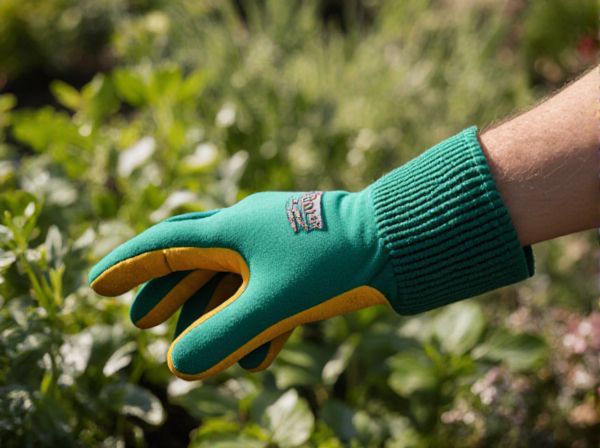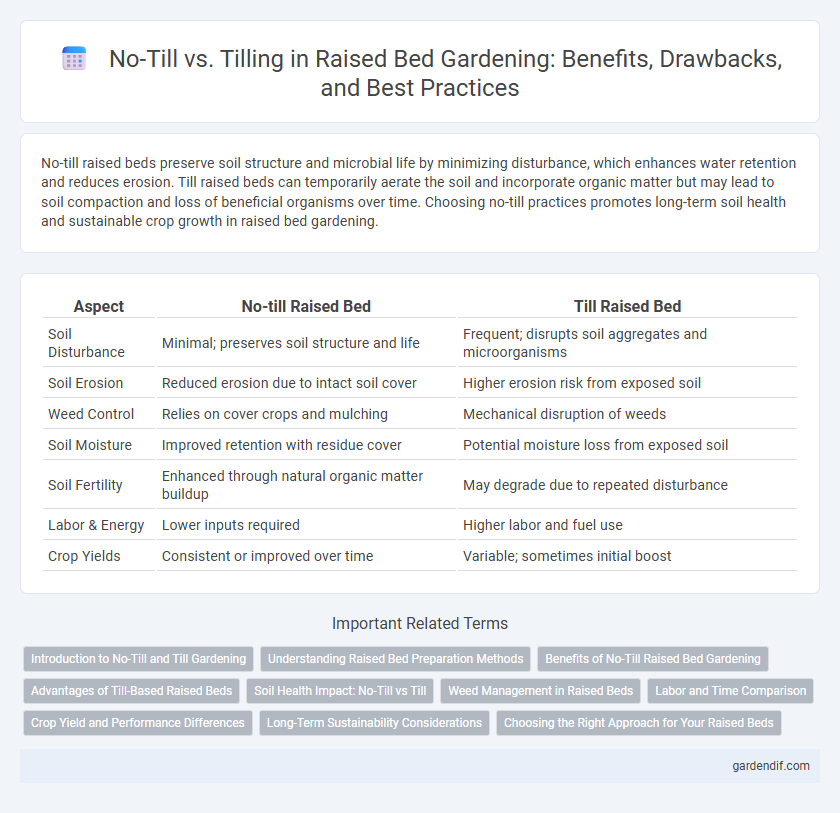
No-till vs Till Illustration
No-till raised beds preserve soil structure and microbial life by minimizing disturbance, which enhances water retention and reduces erosion. Till raised beds can temporarily aerate the soil and incorporate organic matter but may lead to soil compaction and loss of beneficial organisms over time. Choosing no-till practices promotes long-term soil health and sustainable crop growth in raised bed gardening.
Table of Comparison
| Aspect | No-till Raised Bed | Till Raised Bed |
|---|---|---|
| Soil Disturbance | Minimal; preserves soil structure and life | Frequent; disrupts soil aggregates and microorganisms |
| Soil Erosion | Reduced erosion due to intact soil cover | Higher erosion risk from exposed soil |
| Weed Control | Relies on cover crops and mulching | Mechanical disruption of weeds |
| Soil Moisture | Improved retention with residue cover | Potential moisture loss from exposed soil |
| Soil Fertility | Enhanced through natural organic matter buildup | May degrade due to repeated disturbance |
| Labor & Energy | Lower inputs required | Higher labor and fuel use |
| Crop Yields | Consistent or improved over time | Variable; sometimes initial boost |
Introduction to No-Till and Till Gardening
No-till gardening involves cultivating soil without disturbing its structure, preserving beneficial microorganisms and reducing erosion, whereas till gardening relies on turning and breaking the soil to prepare beds. No-till practices enhance soil health and moisture retention by maintaining organic matter and minimizing disruption, promoting sustainable growth in raised beds. Conversely, tilling can increase nutrient availability temporarily but often leads to soil degradation and loss of natural soil ecosystems over time.
Understanding Raised Bed Preparation Methods
No-till raised bed preparation preserves soil structure and microbial life by minimizing disturbance, promoting healthier root development and moisture retention. Tilling breaks up compacted soil and incorporates organic matter but can disrupt beneficial organisms and increase erosion risk. Choosing between no-till and tilling depends on soil condition, crop type, and long-term soil health goals for optimal raised bed productivity.
Benefits of No-Till Raised Bed Gardening
No-till raised bed gardening enhances soil structure by preserving beneficial microbes and earthworm activity, leading to improved nutrient retention and water infiltration. This method reduces soil erosion and compaction, fostering healthier root systems for plants. Additionally, no-till practices minimize labor and fuel costs while promoting sustainable, long-term soil fertility.
Advantages of Till-Based Raised Beds
Till-based raised beds improve soil aeration and nutrient incorporation, promoting healthier root development and higher crop yields. Mechanical tilling helps control weeds more effectively and facilitates the incorporation of organic matter into the soil profile. This method also enhances water infiltration and reduces soil compaction, creating optimal growing conditions for a wide variety of plants.
Soil Health Impact: No-Till vs Till
No-till gardening significantly enhances soil health by preserving soil structure, increasing organic matter, and promoting beneficial microbial activity compared to traditional tilling. Tilled soil often leads to erosion, nutrient depletion, and disruption of soil organisms, reducing overall fertility. Raised beds with no-till practices maintain moisture retention and improve root growth by fostering a stable, undisturbed soil ecosystem.
Weed Management in Raised Beds
No-till practices in raised beds effectively suppress weeds by preserving soil structure and promoting beneficial microbial activity, which reduces weed seed germination. In contrast, tilling disrupts soil layers and can bring weed seeds to the surface, increasing weed pressure and labor requirements. Incorporating mulch and cover crops in no-till systems further enhances weed management by blocking sunlight and outcompeting weeds.
Labor and Time Comparison
No-till raised beds significantly reduce labor and time by eliminating the need for soil turning, which can be physically demanding and time-consuming. Traditional tilling requires multiple steps including digging, breaking clumps, and leveling, often taking several hours per bed. No-till methods streamline planting preparation, promoting efficient soil health management while allowing gardeners to allocate their labor and time to other essential tasks.
Crop Yield and Performance Differences
No-till raised beds enhance soil structure, moisture retention, and microbial activity, leading to higher crop yields compared to traditional tilling. Tilling in raised beds disrupts soil ecosystems and can reduce nutrient availability, negatively impacting plant growth and overall crop performance. Studies show no-till systems in raised beds consistently produce healthier crops with improved resilience and greater long-term productivity.
Long-Term Sustainability Considerations
No-till raised beds preserve soil structure, enhance microbial diversity, and reduce erosion, promoting long-term soil health and sustainability. Tilling disrupts soil ecosystems and organic matter, leading to increased erosion and nutrient loss over time. Sustainable raised bed gardening favors no-till practices to maintain soil fertility and resilience for future growing seasons.
Choosing the Right Approach for Your Raised Beds
Choosing the right soil management approach for raised beds depends on factors like soil health, crop type, and labor availability. No-till methods preserve soil structure and beneficial microbes, reducing erosion and promoting organic matter retention, while traditional tilling helps control weeds and aerate compacted soil. Evaluating your garden's specific needs and environmental conditions ensures optimal productivity and sustainability in raised bed gardening.
No-till vs Till Infographic

 gardendif.com
gardendif.com